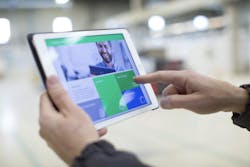Intelligent Infrastructure and Cybersecurity
Today’s global priorities focus on the basics: clean air, clean water and updating the aging infrastructure of highways and bridges, wastewater networks, and even harbor ports and airports. To accomplish this, we must do more than add windfarms or rebuild roadways. We must create greater value for people, and, for that, we need technology.
The digital transformation that most manufacturers are going through today can also impact our cities. The Internet of Things and the cloud are enabling new ways of gathering information and making decisions that not only impact business, but every stakeholder in the supply chain, including citizens.
Imagine this: A mother worried about her child’s allergies wants to check the pollen count in the air to decide if they can go to the playground that day. In Chicago, soon that will be easy to do. By the end of 2017, 500 modular boxes, called nodes, will be installed around the city. The project, called the Array of Things (AoT), uses sensors in the nodes to collect real-time location-based environmental data, including traffic, weather, noise, and air quality—all on a block-by-block basis. The data will be published openly and without charge on a mobile app, which means that that mom will be able to easily track the exposure to air contaminants in her neighborhood.
The value of having intelligent infrastructure is clear. But the worry for many is twofold. First, how can infrastructure be upgraded in an affordable manner? And, second, as we all become more connected, how do we protect ourselves from cyber threats?
Schneider Electric has been investing in R&D and partnerships in order to address these concerns while embracing digitization at the same time.
Serious About Security
As more sensors are deployed, Schneider Electric has created an uncomplicated and inexpensive technology solution that allows people to connect, collect, analyze and act on the data collected, and it is specifically built and targeted for industry.
In partnership with Microsoft’s expertise in providing highly secure, highly distributed data centers around the world along with their Azure cloud computing and services development platform, Schneider Electric has developed a unique set of industrial cloud services that leverage its own rich, deep domain expertise in power management, plants, machines, buildings, data centers and grids. This collaboration empowers companies in a wide variety of markets to accelerate their own digital journey. Schneider Electric enables customers to quickly capitalize on the opportunities being presented by the Industrial IoT (IIoT) and Industrie 4.0 trends as a competitive differentiator. This includes several cloud-based applications available today driving plant, building, people, process and asset optimization.
“If a customer has a data file that they just want to drag and drop onto a website to get started, we have put in the time, money and intellectual property to make sure it really is that easy,” says Saadi Kermani, Global Business Development Manager, Industry Business at Schneider Electric.
For example, a new self-service online portal, online.wonderware.com, includes over 300 drivers to help configure and connect IoT devices to the cloud-based service. “It is super simple and you can start immediately right out-of-the-box,” Kermani says. It is also secure.
The data that is connected to the cloud service is published unidirectionally—outbound only—on an encrypted data stream from the secure port 443. Once the data is in the cloud there are additional layers of cybersecurity in the form of data confidentiality, integrity and availabilty that follow the standards and guidelines of the Cloud Security Alliance (CSA), ISA 62433, NERC Critical Infrastructure Protection (CIP) and the Industrial Internet Consortium (IIC), to name a few examples.
“Then we take another step,” Kermani says. “When we write the code, we follow the security development lifecycle (SDL) approach developed by Microsoft. And we audit ourselves, as well as invite third parties to audit us on a regular basis. If a vulnerability is discovered, we have a Computer Security Incident Response Team (CSIRT) standing by to instantly react.”
In addition, in August, Schneider Electric partnered with Claroty, adding a key component to Schneider’s end-to-end cybersecurity offerings by protecting products connected to the edge of the company’s EcoStruxure architecture. The Claroty continuous threat detection creates a detailed inventory of industrial network assets, identifies misconfigurations, monitors traffic between assets and finds anomalies that may indicate the presence of a malicious actor.
Another partnership with Recorded Future, which applies machine learning and cloud-based tools to monitor emerging issues across the Internet, provides timely information to Schneider’s cyber experts, who then determine which threats are relevant to the company and its customers.
Of course, cybersecurity is a shared responsibility and customers must also do their part to protect themselves. But Schneider Electric has created a holistic cybersecurity system from the device to the transmission of data and the protection of the data once in the cloud.
“We are deeply committed to protecting customer data and providing peace of mind to our customers in order to earn their digital trust” Kermani says.

